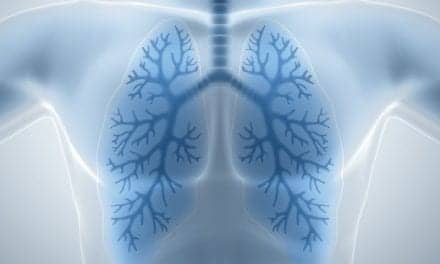Out of the Darkness into the Light
The LAM Foundation is a breath of hope for those with a rare lung condition
Nearly 20 years ago when 31-year-old Susan Jardine of Mill Valley, Calif, was diagnosed with lymphangioleiomyomatosis (LAM), only a handful of physicians in the United States had even heard of the disease. She was told that LAM was a rare and fatal lung disease with no cure. Eight years later, a 22-year-old woman named Andrea Byrnes suffered a collapsed lung on a flight from Cincinnati to Denver. Byrnes, too, was diagnosed with LAM. At that time, the Byrnes family could find only nine women through the National Organization of Rare Diseases who had received the same diagnosis. Thanks to the tireless efforts of The LAM Foundation, scientists are closer than ever to finding a treatment for the disease.

Lymphangioleiomyomatosis, first described in 1919, is characterized by the invasion of smooth muscle tissue into normal pulmonary tissue. “Scientists think LAM is a metastatic disease,” says Sue Byrnes, director and founder of The LAM Foundation and the mother of Andrea, the young woman whose lung collapsed while traveling to Denver. Over time, LAM cells spread and grow, blocking airways and the flow of blood and lymph.
LAM patients are often diagnosed in the prime of their lives and are frequently mothers of young children. Jardine had a 1 year-old daughter at the time of her diagnosis. Symptoms include shortness of breath, pneumothorax, and chest pain. A rare benign kidney tumor called angiomyolipoma is found in 50% of women with LAM. The LAM Foundation has been instrumental in educating the public, researchers, and physicians about the disease.
Major Strides in Research
In the 10 years it has been in existence, The LAM Foundation has raised over $5 million for research. “Our purpose is to provide seed money to scientists so they can collect preliminary data,” Byrnes notes, “then investigators can apply for much larger government research project grants, called RO1s.” The LAM Foundation has had four RO1s stem from its seed money.

“The science didn’t really get moving until the past 5 years,” says Francis McCormack, MD, scientific director for The LAM Foundation and director of the Division of Pulmonary Critical Care Medicine at the University of Cincinnati Medical School. Once the science did start, it did not stop. LAM research has seen three successive breakthroughs—a rare occurrence for even well-funded disease research.
First, Elizabeth Henske, MD, LAM Foundation scientist from the Fox Chase Cancer Center in Philadelphia, discovered a genetic link between tuberous sclerosis (TS) and LAM. Tuberous sclerosis, an inheritable disease, affects roughly 1 million men and women worldwide, and 40% to 50% of women who have TS also have a form of LAM, called TS-related LAM. Non-TS–related LAM, also called sporadic LAM (S-LAM), is not hereditary. The prevalence of S-LAM is roughly estimated to be between 30,000 and 50,000 patients worldwide. Adding the number of TS-related LAM patients to the number of S-LAM patients increases the total projected number of LAM sufferers to between 180,000 and 240,000 worldwide.
The second major breakthrough came when Vera Krymskaya, PhD, LAM scientist from the University of Pennsylvania, Philadelphia, described the molecular basis of abnormal LAM cell behavior. Her work, which showed that tuberin inhibits the growth of LAM cells, moved research in the direction of finding a potential treatment for LAM.
McCormack and other scientists recently completed a small trial targeted at the effect of rapamyacin, an antibiotic that mimics tuberin, on kidney tumors in LAM patients. “But we’re also looking at lung function,” McCormack says. “We’re sufficiently encouraged by what we’re seeing and taking steps to design the next trial.” This small trial was the forerunner to what could be a much larger clinical trial dubbed the SMILES Trial, short
for The Sirolimus Multicenter International Lymphangiomyomatosis Efficacy and Safety Trail: A Phase III, Double-Blind, Randomized, Placebo Controlled Study. SMILES has yet
to receive US Food and Drug Administration approval to use sirolimus, a form of rapamyacin, but The LAM Foundation is optimistic that it will.
McCormack is hopeful that the new, larger trial will prove invaluable in moving the foundation closer to a successful treatment for LAM, and its impact will reverberate throughout the pulmonary field. In 2003, The LAM Foundation became a member of the Rare Lung Disease Consortium, which represents rare lung diseases other than LAM, including pulmonary alveolar proteinosis, a1-antitrypsin deficiency, and SP-C related interstitial lung disease.
“It’s a unique approach to research,” says McCormack. “For a trial to be significant, researchers need to have access to enough patients. Bundling diseases provides access to greater resources and allows more diseases to benefit from scientific findings.” If approved, SMILES will be the first trial funded by the National Institutes of Health’s Office of Rare Disease conducted under the umbrella of the Rare Lung Disease Consortium.
Success Breeds Success
The extraordinary success and successive breakthroughs LAM has experienced would not have been possible without the tireless work of Byrnes and The LAM Foundation. While 10 years ago, a registry of LAM patients did not even exist, today the SMILES Trial gives hope to LAM patients around the world who are eager to participate.

Another early success was the foundation’s lung tissue collection program conducted in conjunction with the NIH. “Our research is dependent on tissue,” says Byrnes. “Several years ago, we hired a histologist to fly to the site of lung transplantations to collect and ship tissue [from the diseased lung] to the lab. We spent over $50,000 in tissue procurement.” By the time Jardine had her lung transplant, The LAM Foundation’s histologist was on site to collect tissue.
“People have treated the disease with antiestrogen therapies, which are based on the observation that only females get it,” says McCormack. Physicians have previously prescribed progesterone, removal of ovaries, and estrogen inhibitors. “There is no good study showing that any of it works,” McCormack adds. Jardine’s physicians tried the traditional treatments to no avail, but many women are still offered such treatments.
Education of LAM patients, the general population, and the medical community is another successful thrust of the foundation. The LAM Foundation has developed a LAM patient Listserv where women with LAM from all over the world connect to discuss their concerns, ask questions, and get information.
The foundation’s advocate program has about 20 women at any one time who are willing to share their stories and give information to newly diagnosed LAM patients who find themselves in similar situations. In addition, the foundation publishes an international directory of women who have given written consent to be contacted by other LAM patients. Byrnes and her staff also publish two newsletters, Breath of Hope solely for LAM patients, and Journeys, which targets a broader audience. Another publication titled Personal Journeys is published annually and contains the stories of 200 LAM patients from around the world.
A recent major accomplishment has been the publication of a 148-page, nine-chapter handbook, The LAM Handbook: A Guide for Patients and Their Loved Ones. This comprehensive book, which details everything from disease basics to coping with lung transplantation, becomes all the more noteworthy, considering that less than 20 years ago, when Jardine was diagnosed, the only written information on LAM that she could find was a single article in The New England Journal of Medicine.
In an effort to reach out to the medical community, The LAM Foundation exhibits at conferences held by the American Thoracic Society, the American College of Chest Physicians, and the European Respiratory Society. “We also work through the TS clinics to educate physicians about LAM and to ask them to screen their patients for LAM,” Byrnes notes. To educate the lay community, the foundation targets women’s groups of all types, including women’s health organizations and college sororities.
“LAM is such a lonely disease,” says Byrnes, explaining that the first time many of the women meet another LAM patient is at the foundation’s annual conference. The camaraderie the LAM patients share is an important component in the conference, but it is also a forum where scientific and practical information is presented to women from around the world.
Byrnes continues to identify more LAM patients and is now working with 10 patient organizations that have sprung up in other countries since The LAM Foundation was started. “I want to encourage patient organizations in other countries,” Byrnes says. “It is my hope that LAM patients around the world will get organized so they can participate in clinical trials. We are desperate for a treatment for LAM.” For more information, go to http://lam.uc.edu/.
Fran Howard is a contributing writer for RT magazine.









